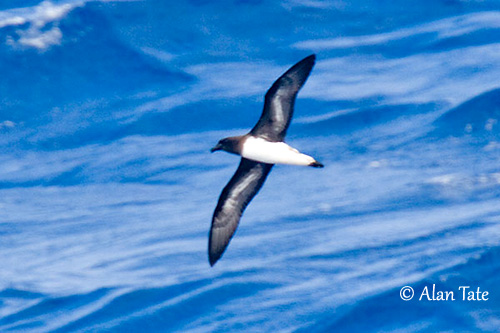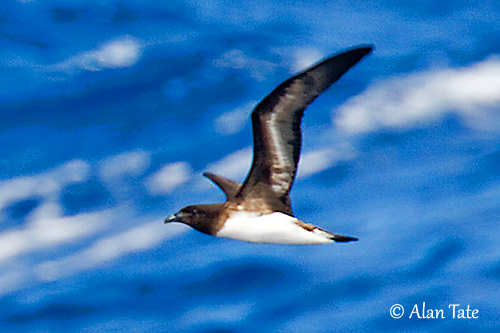
Fr: Pétrel de Tahiti
Ang: Tahiti Petrel
All: Tahitisturmvogel
Esp: Petrel de Tahití
Ita: Petrello di Tahiti
Nd: Tahitistormvogel
Sd: tahitipetrell
Photographers:
Alan & Ann Tate
AA Bird Photography
Text by Nicole Bouglouan
Sources:
HANDBOOK OF THE BIRDS OF THE WORLD vol 1 by Josep del Hoyo-Andrew Elliot-Jordi Sargatal - Lynx Edicions - ISBN: 8487334105
Petrels, Albatrosses, and Storm-Petrels of North America: A Photographic Guide De Steve N. G. Howell – Editor: Princeton University Press, 2012 – ISBN: 0691142114, 9780691142111 – 482pages
OISEAUX DE MER – Guide d’identification de Peter Harrison – Editions Broquet (Canada) – ISBN-10 : 2890004090 – ISBN-13 : 978-2890004092
Oceanic Birds of the World: A Photo Guide De Steve N. G. Howell, Kirk Zufelt – Editeur: Princeton University Press, 2019 – ISBN: 0691197016, 9780691197012 – 360 pages
Birds of Melanesia: Bismarcks, Solomons, Vanuatu and New Caledonia De Guy Dutson – Editeur: Bloomsbury Publishing, 2011 – ISBN: 1408152460, 9781408152461 – 448 pages
Endemia.nc (Pseudobulweria rostrata trouessarti)
Morphometrics and the breeding biology of the Tahiti Petrel Pseudobulweria rostrata
Tahiti Petrel Pseudobulweria rostrata population decline at a nickel-mining site: a critical need for adapted conservation strategies
Tahiti Petrel - First confirmed record for Africa
Page family Procellariidae
Summary cards
Tahiti Petrel
Pseudobulweria rostrata
Procellariiformes Order – Procellariidae Family
INTRODUCTION:
The Tahiti Petrel breeds in South Pacific Ocean and disperses widely across the tropical regions of both Pacific and Indian Oceans after the breeding season. Two subspecies share the range.
This species has dark plumage except the white underparts. It has a stout, bulbous bill, long wings and wedge-shaped tail. It usually appears black-and-white at sea where it spends most of its life, and only comes ashore to breed on volcanic islands. It nests in burrows or rock crevices within loose colonies.
It is known to forage for dead squid but it also takes sea skaters by surface-seizing.
The Tahiti Petrel is threatened by predation and disturbance from introduced species on the breeding grounds. Nickel mining in New Caledonia also has a negative impact on the breeding success.
The population is suspected to be declining, and the species is currently classified as Near Threatened.

DESCRIPTION OF THE BIRD:
Biometrics:
Length: 38-40 cm
Wingspan: 82-86 cm
Wright: 410-520 g
The Tahiti Petrel of nominate race has dark brown hood and upperparts. The hood is often darker while rump and uppertail-coverts are much paler. The dark brown hood extends through breast sides to axillaries.
The underparts are white on lower breast, belly, vent and undertail-coverts, the latter may sometimes have brown spots.
The underwing is dark brown, but the flight-feathers are slightly paler. We can see a whitish line running along the median coverts.
The very stout bill is black. The eyes are dark brown. Legs and base of feet are pale pink while rest of feet is black.
Male and female have similar appearance but the female is slightly smaller.
The juvenile resembles adult.
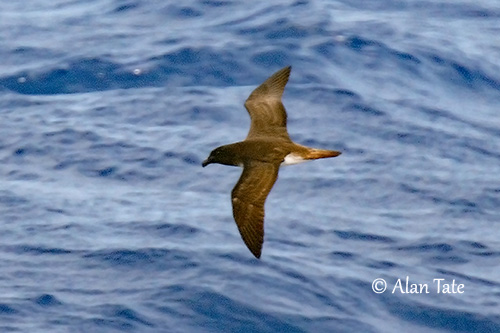
SUBSPECIES AND RANGE:
The Tahiti Petrel has two subspecies.
P.r. rostrata (described above) breeds in Fiji, American Samoa, Society Islands, Marquesas Islands, Gambier Islands, and possibly Rarotonga (Cook Islands). During the breeding season, the nominate race is found in WC Pacific Ocean.
P.r. trouessarti is found in tropical and subtropical Pacific Ocean. It breeds in Vanuatu and New Caledonia.
This race resembles nominate but it has slightly larger bill.
HABITAT:
The Tahiti Petrel breeds on volcanic islands. It nests in burrows or cavities, and forms small colonies in mountain forests. The colonies are usually established on hills and slopes, often on crests or narrow ridges, although some colonies may be at cliff base, below a dense covering of trees and shrubs. It also nests on low coralline islands.
The Tahiti Petrel may occur between 200 and 2,000 metres of elevation. On Tahiti, it can be found up to 12 km inland.
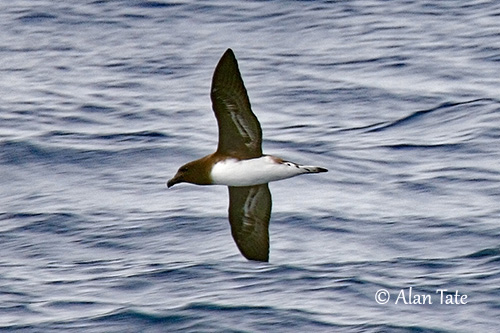
CALLS AND SONGS: SOUNDS BY XENO-CANTO
The calls of P.r. rostrata at the breeding grounds include prolonged nasal shrieks and a long series of whistles ending with a hooting sound. This call is given both in flight and from the ground, including from inside the burrow. The birds call when approaching the colonies in the darkness.
The race P.r. Trouessarti gives mostly a long, upslurred series of whistles while flying, and a braying whistle usually given from the ground.
At the colonies, the Tahiti Petrel produces a long, shrill, nasal whistle that rises first and then quavers.
BEHAVIOUR IN THE WILD:
The Tahiti Petrel is known to take prey from the sea surface, but it forages mainly for dead squid. However, it has been observed taking sea skaters (Halobates) at water surface.
It may forage close to other seabirds, especially the Wedge-tailed Shearwater when they breed in sympatry in a tropical area, but also in association with surfacing pilot whales (Globicephala species).
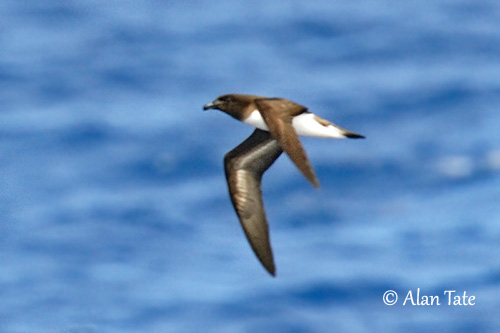
The breeding behaviour of the Tahiti Petrel is poorly known, but some observations at Nemou Island, on the eastern coast of Grande Terre in New Caledonia, have made it possible to describe some habits of this species.
The Tahiti Petrel nests on steep slopes in mature forests. It needs rocky substrate and deep soil to excavate the nesting burrow. These burrows are scattered in small colonies or isolated pairs. From the same study, the breeding success is lower in rocky cavity than in burrow, especially with large entrance.
The Tahiti Petrel is a nocturnal, cryptic species. It returns on land at night to breed, incubate the egg or feed the chick. At the beginning of the night, a high vocal activity can be heard.
It uses three types of burrows. It may be excavated under a root or a boulder, or dug in the soil, or the birds use a rocky cavity.
This species lays a single egg and both adults share the nesting duties.
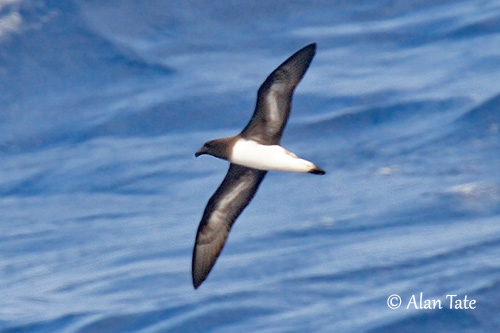
The Tahiti Petrel is strongly pelagic after the breeding season. It ranges across the tropical waters of the South Pacific Ocean, and may occasionally reach the adjacent subtropical waters off Australia and New Zealand.
As they disperse widely, they have been recorded NE to Mexico and Peru, NW to Taiwan, and SW to the Mozambique Channel.
The race P.r. Trouessarti is said to range north at sea from New Caledonia as far as Bismarck Archipelago. Some of them are seen off E Australia, S to central New South Wales and around New Guinea, off Port Moresby.
The Tahiti Petrel has long, pointed wings, making it able to cover large areas while foraging. The flight includes low glides over the water, during which the wings are upturned with one pointing at sea surface and one straight up while arcing and banking during long periods. Short bursts of shallow flapping alternate with the glides.
In strong winds, the flight of the Tahiti Petrel resembles the flight of an albatross.
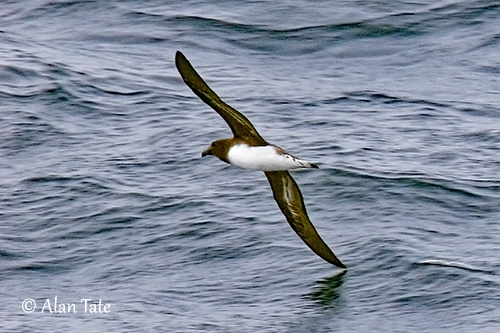
REPRODUCTION OF THIS SPECIES:
The breeding season extends year-round on Tahiti, Raiatea and the Marquesas, but a peak egg-laying apparently occurs between March and July on Tahiti where numerous fledglings are found between July and September, indicating a breeding season from March to October.
The Tahiti Petrel breeds in loose, small colonies. It nests in burrows or rock crevices.
In New Caledonia, the race P.r. Trouessarti nests up to 500 metres of elevation on Grande Terre, the main island.
On Tahiti, the nests are located between 150 and 2,000 metres above sea-level.
The female lays a single egg. From a study in New Caledonia, the incubation lasts about 54-56 days. At hatching, the chick is covered in dark brown down, but the underparts are whitish. It fledges 110-120 days after hatching.
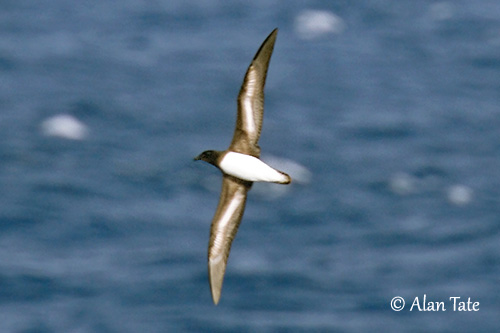
PROTECTION / THREATS / STATUS:
The Tahiti Petrel is heavily affected by predation and disturbance from invasive species such as feral cats, rats (Rattus), dogs and pigs that contribute greatly to declines and low breeding success. Deers are also a potential threat by trampling the burrows and damaging the breeding grounds. In the colonies where the Tahiti Petrel breeds close to the Wedge-tailed Shearwater, competition for burrows is intense.
In New Caledonia, mining activities, especially nickel mining, have a severe, negative impact on breeding success and adult mortality. Light pollution and collisions with electric powerlines also involve adult mortality.
The global population is roughly estimated at 20,000/30,000 individuals, and it is probably declining.
The Tahiti Petrel is currently classified as Near Threatened.
